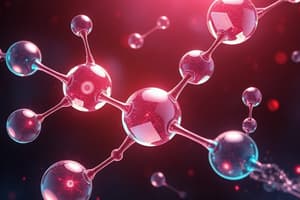Podcast
Questions and Answers
What determines the element of an atom?
What determines the element of an atom?
- The number of neutrons
- The number of protons (correct)
- The number of electrons
- The mass number
Which particles are located in the nucleus of an atom?
Which particles are located in the nucleus of an atom?
- Electrons and neutrons
- Neutrons and ions
- Protons and electrons
- Protons and neutrons (correct)
What is the molecular formula for glucose?
What is the molecular formula for glucose?
- C12H6O6
- C6H12O6 (correct)
- C6H6O12
- C6H12O12
What type of bond involves the sharing of electrons between atoms?
What type of bond involves the sharing of electrons between atoms?
What is the correct name for NaCl?
What is the correct name for NaCl?
Which type of compound uses prefixes to indicate the number of atoms?
Which type of compound uses prefixes to indicate the number of atoms?
What defines an isotope of an element?
What defines an isotope of an element?
Which of the following is an example of a binary acid?
Which of the following is an example of a binary acid?
What is typically used to name organic compounds based on the number of carbons?
What is typically used to name organic compounds based on the number of carbons?
What is the total number of protons and neutrons in the nucleus of an atom known as?
What is the total number of protons and neutrons in the nucleus of an atom known as?
Flashcards are hidden until you start studying
Study Notes
Atoms
- Definition: The basic unit of matter; smallest unit of an element.
- Structure: Composed of protons, neutrons, and electrons.
- Protons: Positively charged, located in the nucleus.
- Neutrons: Neutral charge, also in the nucleus.
- Electrons: Negatively charged, orbit the nucleus in electron shells.
- Atomic Number: Number of protons in an atom; determines the element.
- Mass Number: Total number of protons and neutrons in the nucleus.
- Isotopes: Atoms of the same element with different numbers of neutrons.
Molecules
- Definition: Two or more atoms bonded together.
- Types of Bonds:
- Covalent Bonds: Atoms share electrons (e.g., H2O).
- Ionic Bonds: Transfer of electrons from one atom to another (e.g., NaCl).
- Molecular Formula: Shows the number and type of atoms in a molecule (e.g., C6H12O6 for glucose).
- Structural Formula: Represents the arrangement of atoms and bonds in a molecule.
Naming Compounds
-
Ionic Compounds:
- Composed of cations (positively charged) and anions (negatively charged).
- Name the cation first, followed by the anion.
- Example: NaCl is sodium chloride.
-
Covalent Compounds:
- Use prefixes to indicate the number of atoms (mono-, di-, tri-, etc.).
- The first element is named as is, the second element is modified to end in -ide.
- Example: CO2 is carbon dioxide.
-
Acids:
- Binary Acids: Composed of hydrogen and one other non-metal (e.g., HCl is hydrochloric acid).
- Oxyacids: Contain hydrogen, oxygen, and another element (e.g., H2SO4 is sulfuric acid).
-
Organic Compounds:
- Named based on the longest carbon chain and functional groups.
- Common prefixes indicate the number of carbons (meth-, eth-, prop-, but-, etc.).
- Suffixes indicate functional groups (e.g., -ol for alcohol, -oic acid for carboxylic acids).
Atoms
- Basic unit of matter; smallest entity of an element.
- Contains protons (positive charge) and neutrons (neutral charge) in the nucleus.
- Electrons (negative charge) orbit the nucleus in electron shells.
- Atomic Number represents the number of protons and identifies the element.
- Mass Number is the sum of protons and neutrons in the nucleus.
- Isotopes are variations of an element differing in neutron count.
Molecules
- Formed by two or more atoms bonded together.
- Covalent Bonds involve shared electrons (e.g., water - H2O).
- Ionic Bonds result from the transfer of electrons (e.g., sodium chloride - NaCl).
- Molecular Formula indicates quantity and type of atoms in a molecule (e.g., glucose - C6H12O6).
- Structural Formula displays the arrangement of atoms and the bonds between them.
Naming Compounds
- Ionic Compounds consist of cations and anions; cations are named first followed by anions (e.g., NaCl = sodium chloride).
- Covalent Compounds utilize prefixes (mono-, di-, tri-) to indicate the quantity of atoms; first element retains its name while the second ends in -ide (e.g., CO2 = carbon dioxide).
- Acids categorized into:
- Binary Acids: Hydrogen combined with a non-metal (e.g., HCl = hydrochloric acid).
- Oxyacids: Contain hydrogen, oxygen, and another element (e.g., H2SO4 = sulfuric acid).
- Organic Compounds named by identifying the longest carbon chain and functional groups; common prefixes denote carbon atom count (meth-, eth-, prop-, but-), and suffixes indicate functional groups (e.g., -ol for alcohol, -oic acid for carboxylic acids).
Studying That Suits You
Use AI to generate personalized quizzes and flashcards to suit your learning preferences.




